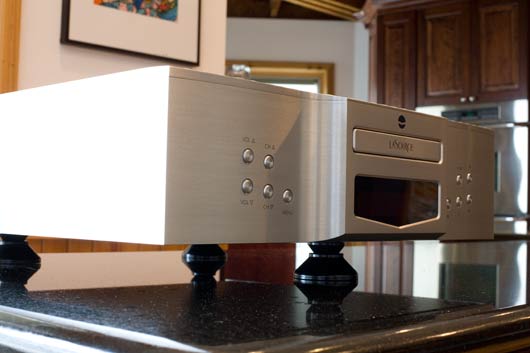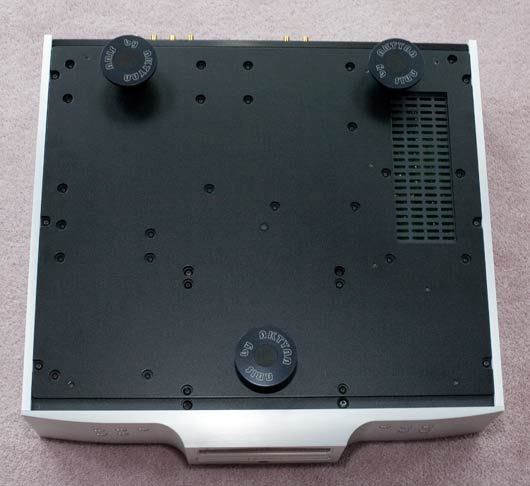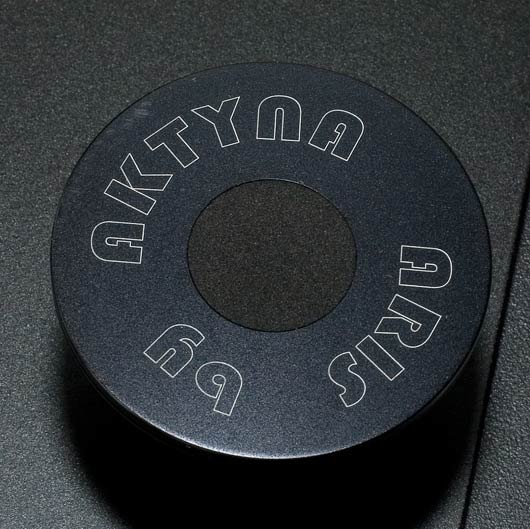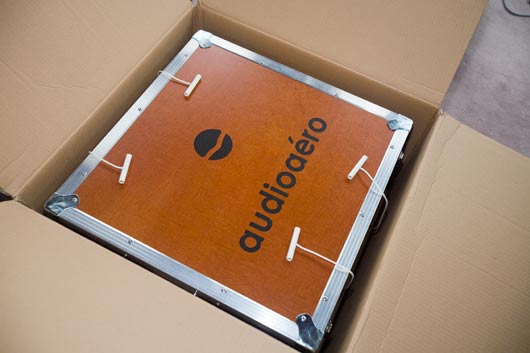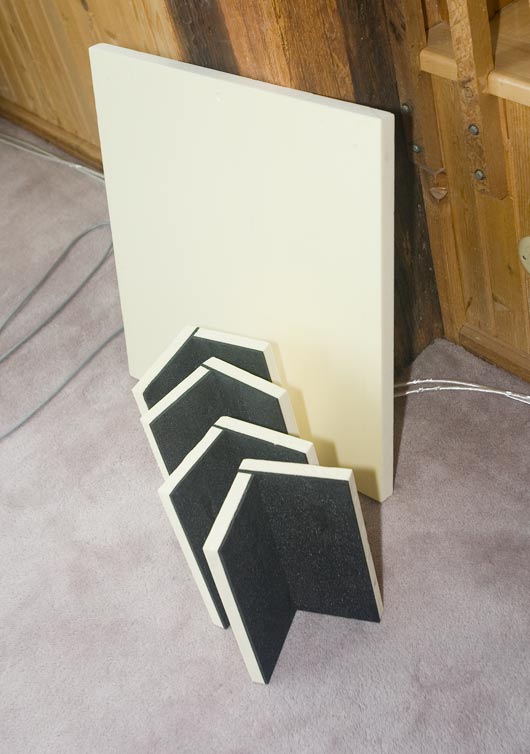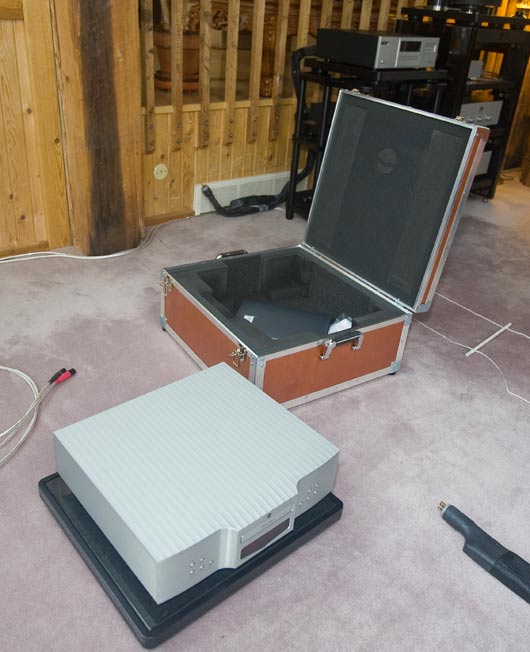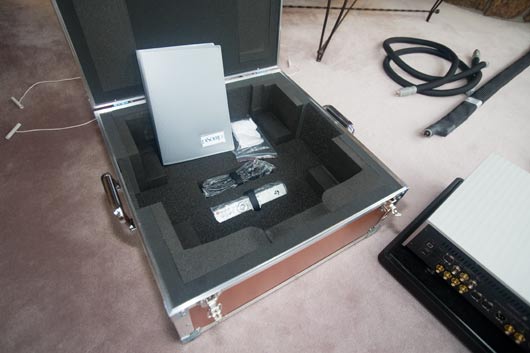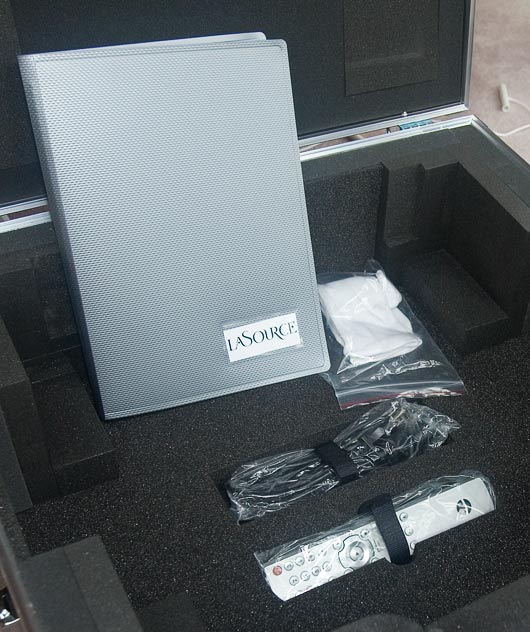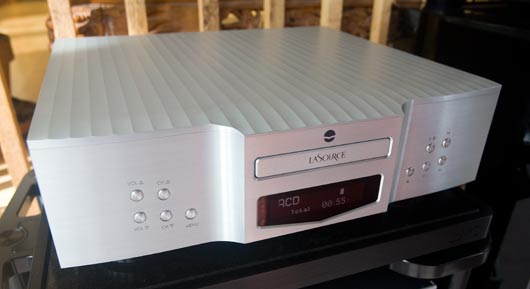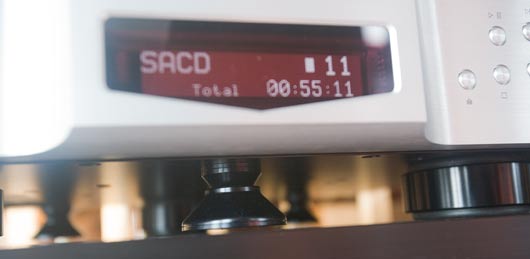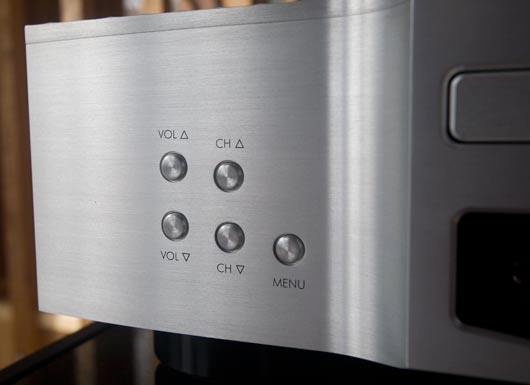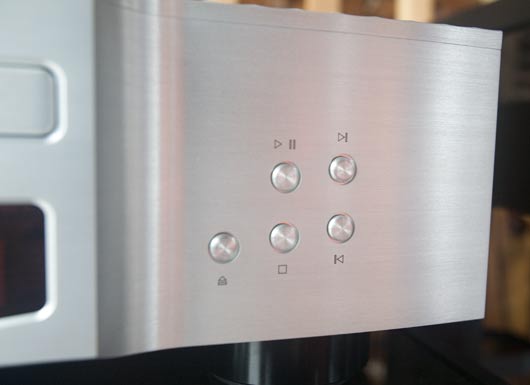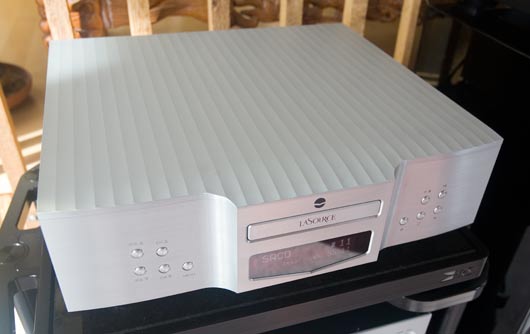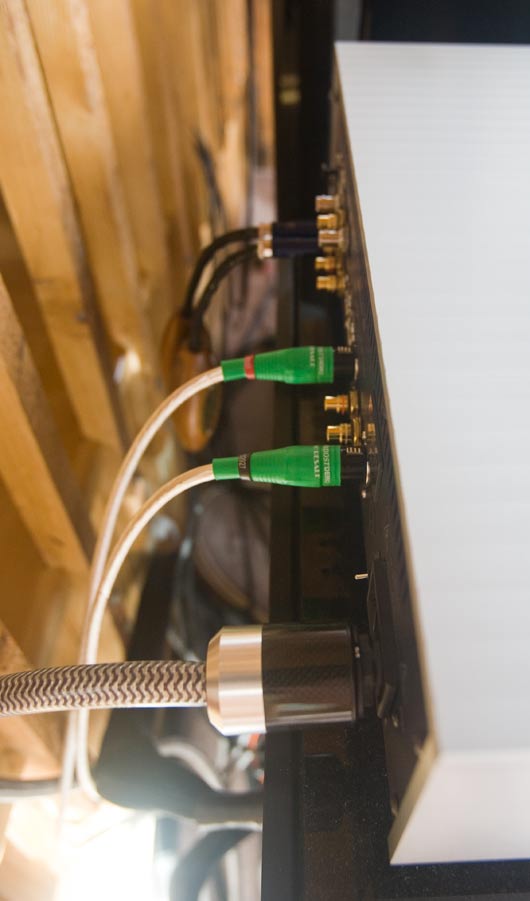SOUND.
The first thing we did was to hook up the player to the Edge NL Reference ‘pyramid’ amplifiers.

We noticed several things. That the sound was warmer and more approachable than it had been with the solid-state Emm Labs player [more on this shortly]. We also noticed a high noise floor between notes. We thought nothing of this, really, since we had just come from RMAF and a system that had the lowest noise floor of any system we know how to build. But it was kind of ‘Oh Jeez, well, this is kind of too bad’ but we had a lot to do and we just let the player warm up for the rest of the evening and into the next day – playing this and that CD in the background – doing careful listening every so often – but no shootouts or anything.
From our past experience with the Audio Aero Capitole and Prestige, we know that using HRS Nimbus underneath the players helped lower the noise floor and increase definition. From my office the sound was sounding ‘out of tune’ [it is often easier to hear this off-axis or in another room, for me anyway]. So I finally badgered Neli [yeah, spouses need to be badgered about 99.9% of the time if you want them to do something when YOU want them to do it] into helping find 3 sets of Nimbus and slide them under the player while I lifted it. It was then that we noticed that the factory-supplied feet looked like Stillpoints and not the standard BDR cones. Regardless, we slid them under [these medium height ones are just tall enough to lift the player off of the feet]. And pressed play.
It was an ENTIRELY different player. My first statement was, ‘Oh no, we just wasted a *day* and have to start our listening impressions all over again’ . Listening from my office revealed that timbre was back into the normal range we hear with most gear. Closer listening revealed that there was now plenty of space between the notes. The only negative, if you want to call it that, was that the sound was not quite as overtly ‘warm’, which was apparently just a lot of notes decaying noisily into the start of other notes. [more about this below].
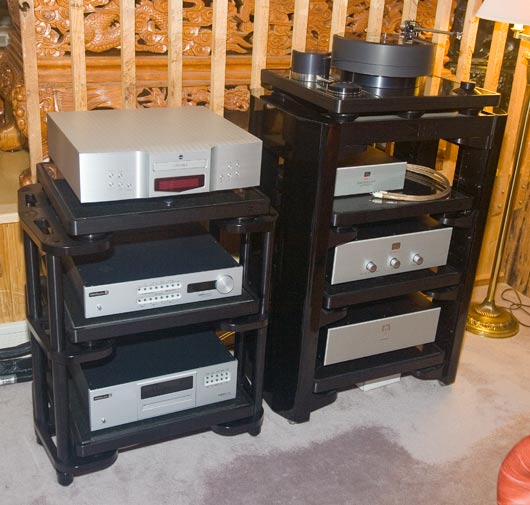
SHOOTOUT
We did the shootout with the LaSource taking on the Emm Labs CDSD-SE / DCC2-SE CD/SACD player with linestage.
Why is this a good comparison and why is it bad?
Good: They are both CD/SACD players with line stages
Bad: the LaSource costs twice as much as this Emm Labs pair.
Bad: The Emm Labs player we are using in the shootout is a few generations behind the newest Emm Labs players [the shootout SHOULD be between the LaSource and the XDS1 player + new Emm Labs PRE2 linestage – both because the prices would then be approximately equal and because these are their latest and greatest products].
Good: (and this is the real reason) The rap against tubed players [actually this is a solid-state player with a tube linestage – but almost everyone will use the linestage – so bear with me here] is that they are fuzzy, and lack detail, and are inaccurate. So what better test than to compare it with one of the best 4 or 5 solid-state players [the others being mostly other Emm Labs players :-)]. The CDSD/DCC2 is detailed but not overly detailed, accurate and predictable. Whether you respect these players as much as we do or not, you have to admit that they are a great representative of solid-state player competence with which to compare the new LaSource upstart against.
OK. We had Kevin assist us as he does with many of our shootouts here [thanks Kevin!] Kevin is able to listen carefully and talk about what he is hearing. His preferences are slightly to the ‘Heart’ side of neutral, Neli slightly to the ‘mind’ side of neutral, and me, I think I am in the middle somewhere.
Our test tracks were [we had 4 this time instead of our usually 3, which was good and bad: more test tracks is good, the longer periods between hearing the track on one configuration versus another is bad]:
Sailing to Philadelphia (Knopfler, Taylor; title track [this is wearing a hole in our brains too, but it allows us to immediately compare each player to 100s of other systems, as well as to the other player, and also helps keep us from getting things into a weird state and not knowing it)
Nelson’s Mass (Haydn; King’s College Choir (decca legends) track 1)
Amnesiac (Radiohead; track 2 [track 1 is wearing a hole in my brain, so we are now using #2])
Tumbleweed Connection (Elton John, SACD, track 6 ‘Where to now St. Peter?’)
We ran both players through their internal linestages into the Audio Note Ongaku [yes, 2 linestages in the chain – but it worked wonderfully well]. We put Elrod powercords on the Emm Labs and an Acrolink Mexcel powercord on the Audio Aero. The idea was to kind of assist them in sounding more like the other player: the LaSource will now tend to sound more detailed and the Emm Lab more relaxed and open – i.e. the characteristic sound of these two brands of power cords. We also put HRS Nimbus Couplers under the Emm Labs CDSD transport and DCC2 DAC/linestage to match those under the LaSource.
[Jim P., if you are reading this, this is the same demo you heard except for the power cord changes and the HRS under the Emm Labs – which did make them sound much more alike – but which we do not think in anyway invalidates your choices, but in fact make us more confident you made the right choice for your particular preferences]
IMPRESSIONS
First, we were all amazed at how close the players were to each other. The EMM Labs is much more musical than one might think, given that it is solid-state, and the Audio Aero LaSource had a lot more detail and a quieter background than one might think from hearing their earlier players or looking at their design [aka It Has Tubes!].
We all agreed that the LaSource is a remarkable achievement. It’s a huge step forward from their previous generation top of the line CD/SACD player, the Prestige.
In some sense the ultimate goal, the holy grail [from our point of view] is for the LaSource to sound like an Emm Labs player [aka the best solid-state player] with a little [some amount anyway] of that vacuum tube warmth and soul. To a large extent this is what it sounds like Audio Aero may be attempting to do with the LaSource.
I will transcribe the notes I took of the shootout – in order – so you can get a feeling for the evolution of our analysis of the LaSource sound. We pretty much discussed and agreed to each of these points.
LaSource: Sweet sounding (Haydn). Slightly less air causing voices to be ever so slightly compressed generating a more solid image of the singers (Sailing to Philadelphia). Slightly less micro-dynamics causing some notes to be the tiniest bit more strident, and others to be richer sounding.
EmmLabs: More clarity and voices easier to understand. Again, imaging not quite as solid, less vibrato on the voices and instruments. Surprisingly, only *slightly* less rich. The PRaT here was equal but different [the smaller notes carrying much of the drive of the song on the Emm Labs and the stronger notes driving the song on the LaSource (Sailing and Radiohead)]
The LaSource was complemented here on how fast it loads CDs – much faster than the Prestige [most new SACD players now are quite a bit faster than the older SACD players]
The EmmLabs has less bloom. Soundstage depth was greater (Haydn) [I think that the soundstage depths are differently formed, EmmLabs separated out each violin, the LaSource grouped things together more, but still had depth].
On the Haydn [everything really] the EmmLabs was more real but it could also be a little less engaging [though we HAD heard most of these tracks about, literally, 50 times on EmmLabs in the last 3 weeks :-/]. It depends on how you are listening. The LaSource is easy to listen to [I was going to say more approachable, but my notes has us agreeing that voices were more approachable on the EmmLabs because they were more articulate and easier to understand. Yet, on the LaSource, the voices were more solid and present]. I hope you can start to see how close these are to each other, and also how they are different and in what ways they are different. Perhaps it is more about just how deep do you want to be ABLE to listen and about how deep you USUALLY listen.
Elton John. There was a stark difference here and we all agreed that 1) that Elton track is jaw-droppingly magical, 2) that the magic dust must be in the very subtle details because the EmmLabs picked it up and the LaSource did not [but see note on using the Nordost Odin power cord on the LaSource below], 3) I shock myself thinking about buying a CD, the first in several years [I usually want to get the LP first, and then later get the more expensive CD if I really like it. Besides, we have 4 – 5000 CDs, seems stupid to buy more when there are some here I have not heard for decades. Luckily Kevin left the CD here for us to drench ourselves in]
RadioHead. The EmmLabs picked up the subtle background information [swirlies] that the LaSource did not (+1 for Emm). The voices were more solid and present on the LaSource (+1 for LaSource). The foreground effects [big swirlies :-)] were more solid and present and tonally rich with the LaSource (+1 for LaSource). So the vote [we listened to all of these several times and had the same discussion every time :-)] was +2 to +1 in favor of the LaSource in terms of how much fun it was to listen to this track.
Haydn, Sailing to Philly: We never brought these two to a vote, but hopefully from the above, you will understand that there are pluses and minuses depending on how you look at music and how you listen. Since we all listen differently at different times, this can get somewhat confusing – and in some sense that was what we had to deal with when looking at the differences.
A few notes on extracting the last bit of low level detail with this player. Although we had a very good power cord on the player, the Acrolink 7100 series (about $2500) we did try to keep shootout fair. We COULD have used the Nordost Odin power cord to extract MUCH more low level information.
The Audio Aero LaSource, then, is a very good DAC combined with a tube linestage that adds a slight spice of warmth, bloom and soul to the music. It is extremely tasteful in its restraint – just adding enough to ‘sweeten’ but not ‘overwhelm’.
People who like the Audio Aero sound will LOVE this player. {{Neli says: It’s got the classic Audio Aero voicing, with better everything — PRaT, detail, extension, lower noise floor. And it’s got one of the big Esoteric drive mechanisms, built like a tank — so we all hope that the transport issues that plagued the Prestiges are over. forever.}}
People who like their system to ALWAYS be fun to listen to, and yet still hear almost the same level of detail as one of the worlds best solid-state players, will LOVE this player.
We will be shipping a free set of three HRS Nimbus, to use instead of the factory-supplied feet, with every player we ship.



